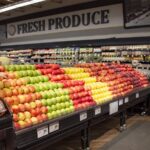Check out the yogurt aisle at your local grocery store, and it looks like there are endless options. In reality, though, just four companies own virtually all the brands on display. Head next to the snack aisle for some chips and dip – can’t decide between Fritos, Lay’s or Tostitos? Doesn’t really matter, because they’re all owned by the same company. And you might think you’re supporting small businesses by opting for organic brands throughout the store, but chances are they’re owned by the same megacompanies that sell the big name brands.
It’s all part of a growing “food monopoly consolidation crisis” that one advocacy group says is giving us far fewer choices – and far higher prices – than we’re led to believe.
Food & Water Watch describes the situation in a new report, entitled “The Economic Cost of Food Monopolies: The Grocery Cartels.”
“While the COVID-19 pandemic dealt a blow to many parts of the economy, one sector saw record-breaking profits: the grocery industry,” the report begins. “Americans, however, faced rising food costs and widespread shortages of some staples.”
The report calls out large grocery retailers, and large grocery brands, for getting too big and making too much off the backs of workers, farmers and consumers. And it’s calling on government regulators to get involved.
The report examined 55 different grocery categories, encompassing nearly every type of product throughout a typical grocery store, and found that just eight are what it considered “highly competitive.” The rest are dominated by just a few big food companies. Yogurt, for example, has “enough flavors and brands to fill an entire supermarket showcase,” the report states, yet just four companies account for three-quarters of all yogurt sales. Danone dominates the refrigerated soy milk market with 80% of all sales, and PepsiCo’s various brands capture 88% of all dip sales.
And when it comes to natural and organic brands, big food companies could be behind those as well. “Shoppers might think they are ‘voting with their dollars’ by supporting brands and companies that share their values,” the report reads. “In reality, their dollars are going to the same agribusinesses that also peddle sugary cereal and other junk food.”
In short, the report warns shoppers not to be fooled into thinking they have as much choice as it may appear. “Brand variety masks the problem of consolidation,” the report reads. “Supermarkets might present a façade of variety and choice, but chances are you are choosing between just a handful of companies for each supermarket item.”
So what’s the problem with that? Lack of competition can lead to higher prices, Food & Water Watch warns. And it’s not just lack of competition among grocery manufacturers that the group is concerned about.
The report warns that big grocery retailers themselves are getting bigger, giving shoppers fewer choices. “The combined market share of the four largest grocery retailers tripled from 23% in 1993 to 69% in 2019,” the report reads. “Walmart alone gobbles up $1 out of every $3 spent at grocery retailers.”
The trend is toward fewer, larger stores owned by fewer, larger companies, which the group says is “designed to funnel wealth from local communities into the hands of corporate shareholders and executives.” The report stated that “growing market concentration usually leads to a rise in food prices,” even if the retailers promise otherwise. Walmart, for instance, positions itself as the low-price leader. But “those low, low prices… do not necessarily stick around,” the report warns. “Walmart has been known to raise food prices once it becomes the dominant grocery retailer in town.”
The report concludes that “we must pressure our elected officials to strengthen our antitrust laws and enforce existing ones.”
“The grocery cartel has created an illusion of choice and efficiency to disguise their profiteering off of the American consumer who is unwillingly asked to trade abundance for resilience,” Food & Water Watch Research Director Amanda Starbuck said in a statement. “We envision a U.S. food system more resilient, just and sustainable than the one we have today. To get there, we need to address the rampant food monopoly consolidation crisis on our hands.”
So don’t be fooled, the group warns, by grocery aisles full of seemingly endless options. In reality, whether it’s the brands you buy or the store where you shop, there are fewer choices than it may appear – and shoppers, in the end, may be paying the price.
















